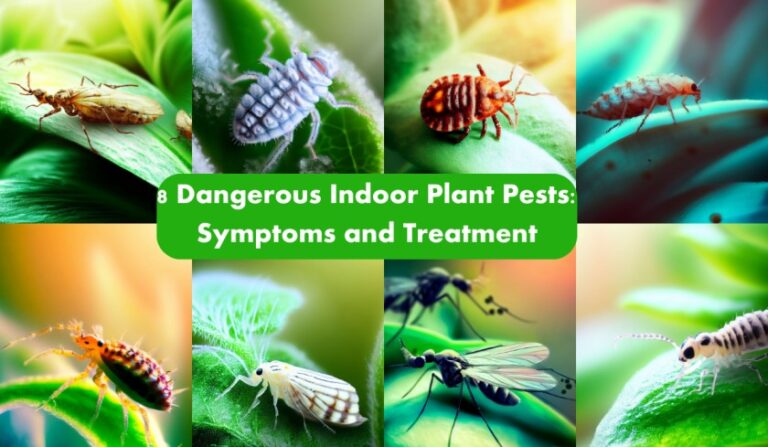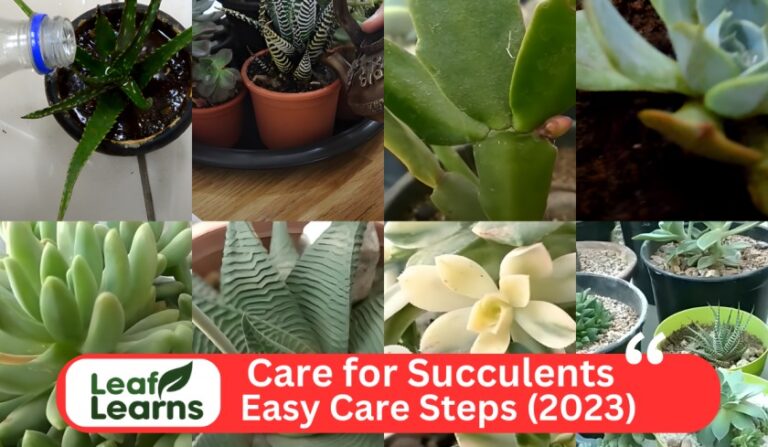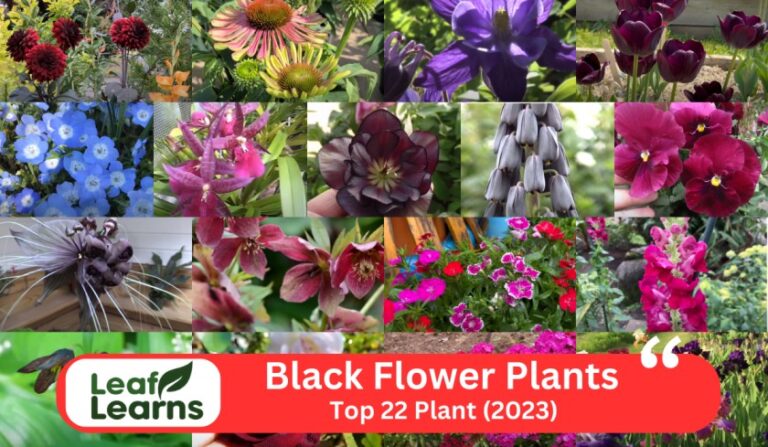Why Are My Caladium Leaves Turning Yellow (2024)
Issues that can be shown through the Caladium leaves turning yellow include overwatering, nutrient deficiencies and insufficient light. This discoloration can result in poor photosynthesis, which affects the plant’s capability to generate energy.
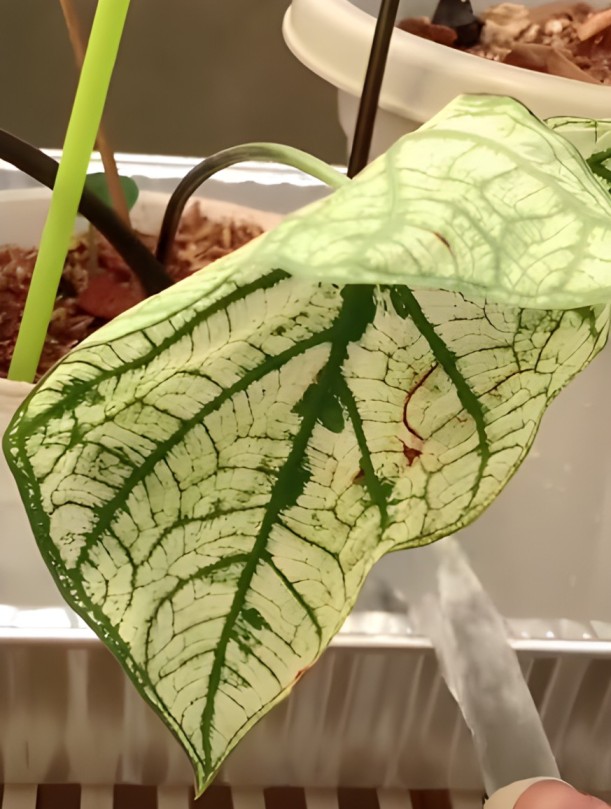
If not addressed, the effects could result in stunted growth, lower overall health and a lesser attractive appeal for the plant. To sustain the variegated leaves of Caladium, monitoring it regularly and adjusting watering schedules as necessary along with providing ample nutrients.
Caladium leaves may turn yellow due to overwatering, as these plants prefer well-drained soil. Furthermore, too much sun can scorch their fragile leaves, which results in yellowing. Another factor might be inadequate nutrition, especially if important elements like nitrogen are lacking. This may be fixed by modifying your watering schedule, offering partially shaded areas or filtered sunshine, and making sure your fertiliser is nitrogen-balanced. Finally, look for bugs. Yellowing can result from infestations; treat with insecticidal soap if needed.
Contents
- 1 Why do Caladium Leaves Turn Yellow?
- 2 How to Prevent Caladium Leaves turning yellow
- 3 How do you take care of yellow Caladium leaves?
- 4 Comprehensive guide to Effective Caladium Plant Care and Troubleshooting Yellowing Issues
- 5 FAQs
- 5.1 Why are my caladiums turning yellow?
- 5.2 How do you keep caladiums happy?
- 5.3 How do you make caladiums fuller?
- 5.4 Why is my caladium losing color?
- 5.5 Can Removing Yellow Leaves Help?
- 5.6 Can Yellow Leaves Turn Green Again?
- 5.7 Is it necessary to cut off yellow leaves from a caladium plant?
- 5.8 Does a lack of nitrogen cause yellow caladium leaves?
- 5.9 Will too much water cause my caladium leaves to turn yellow?
Why do Caladium Leaves Turn Yellow?
There are many causes of Caladium leaves turning yellow and we will discuss this in the article.
Overwatering
The overwatering is often the cause of caladium leaves turning yellow. While these tropical plants like water, too much of it may cause root rot that starves the plant of necessary nutrients.
Water-logged soil causing yellowing leaves also shows that the plant is not able to absorb oxygen; this prompts stress.
How to Fix It
To rescue your caladiums, deal with overwatering immediately. First of all, be sure to provide adequate drainage by replanting the plant in a well-draining soil mix.
Leave the top inch of soil to dry before watering again and avoid wet or soggy conditions. Change your watering frequency depending on the needs of your caladium and overall humidity.
Try using a saucer under the pot where excess water can collect and let the soil breathe.
Underwatering
Caladium leaves turning yellow is also caused by the underwatering. Inadequate water causes these tropical showpieces to lose their vitality, resulting in yellow leaves and a dull-looking display.
How to Fix It
It is easier to bring your caladiums back than you might imagine. First, change your watering procedure caladiums love wet soil all the time.
Deep water the plant, soaking the roots. Mulching with organics helps conserve soil moisture. Buy an appropriate potting medium with excellent drainage.
Too much bright light
However, if the Caladium leaves turning yellow, it could be due to an over-exposure to bright light.
Although these bright plants love light, too much of it may produce warning signs that are always yellow leaves. Caladiums require indirect light and so will readily scorch if exposed to intense sunshine for many hours.
How to Fix It
Adjust Placement: Place your Caladium in a little shade. To keep that lush green cover, shield it from the strong midday rays.
Use Sheer Curtains or Filters: Alternatively, introduce sheer curtains or filters to soften sunlight which is ideal for Caladium.
Temperature Stress
Temperature stress is a frequent cause of Caladium leaves turning yellow. Because they thrive in warm tropical climates, these bright foliage plants are temperature-sensitive.
Temperatures that are either abnormally high or low can cause leaf discoloration when they are exposed. The issue is only exacerbated by watering inconsistency as the moisture content fluctuates with temperature changes.
How to Fix It
To save your Caladium from the dominion of temperature stress, create a stable environment. Shade plants from sunlight in scorching hours and have proper shade to not overheat.
In colder time frames, make sure they’re protected from cool breezes. Keep up a regular watering schedule that provides enough moisture to keep the soil damp but not soggy.
Improper Potting Soil
The root of yellow leaves on Caladium can actually come from somewhere else improper potting soil. When this balance is disturbed, however, caladiums can start to show yellow leaves instead.
To flourish, these plants need soil that drains well and has a slightly acidic pH level. Waterlogged or heavy soil may interfere with proper drainage and thus lead to root rot and nutrient deficiencies, both causes of yellowing leaves.
How to Fix It
It takes some soil play to bring back the lush green glory of your Caladium. Go for an airy mixture that is enriched in organic matter, say a preparation of peat moss, perlite and pine bark.
That the pot is covered with holes to prevent waterlogging. Transplant the Caladium, taking care not to remove too much soil from the roots.
Natural Aging
As we know that natural aging is also caused caladium leaves turning yellow. Since it transfers its energy into new growth, the plant internalizes the wilting older leaves losing their luster slowly.
Although this is a natural part of the caladium life cycle, knowing how to deal with it guarantees a healthy growing plant.
How to Fix It
In an attempt to prevent yellowing resulting from natural aging, pay attention to the best possible treatment. Make sure your caladium gets sufficient sunlight, which should be filtered or indirect, and a regular watering routine.
Removing yellow leaves near the base will help the plant redirect nutrients to healthier foliages. It is during the growing season that fertilization with a balanced fertilizer can enable growth of essential nutrients for plant vitality.
Leaf Burn and Drying Out
Caladium leaves turning yellow can be caused by leaf burn and drying out. This happens if the plant gets too much sunlight or if the soil is always dry.
Caladiums grow well in indirect light where prolonged direct sun would burn the leaves, causing them to turn yellow. Inadequate watering causes soil drying that in its turn withdraws needed moisture and nutrients from the plant.
How to Fix Leaf Burn
To fix leaf burn, move your caladium to a location where it receives filtered or indirect sunlight. Protect it from the hot afternoon sun to prevent further damage.
Saturate the soil evenly so that there is both hydration and drainage. Try mulching for soil moisture retention and temperature regulation.
How to Fix Drying Out
You can combat drying by creating a watering schedule. Maintain the soil moist at all times but not wet. Within the environment, adjust watering frequency so that the plant is hydrated adequately.
Rust and Southern Blight
It is the rust and Southern Blight, that are these common enemies of your Caladium plant turning its vibrant green leaves yellow.
Rusts, which are fungal diseases that appear as orange-brown spots on the foliage, and Southern Blight, caused by a soil-borne fungus that leads to yellowing of the plants wilting and decay.
How to Fix Rust
To prevent Rust, cut off infected leaves and improve airflow by removing dense vegetation around plants; apply fungicides containing copper.
Keep your humidity levels optimal and avoid overhead watering to limit the dispersal of rust spores. Such a preventive measure will revive the class of your Caladium’s leafy grace.
How to Fix Southern Blight
Southern Blight reclamation implies soil improvement and fungicidal treatment. Immediately remove diseased plants, treat the soil with fungicides and use crop rotation to deter perpetuation of this fungus.
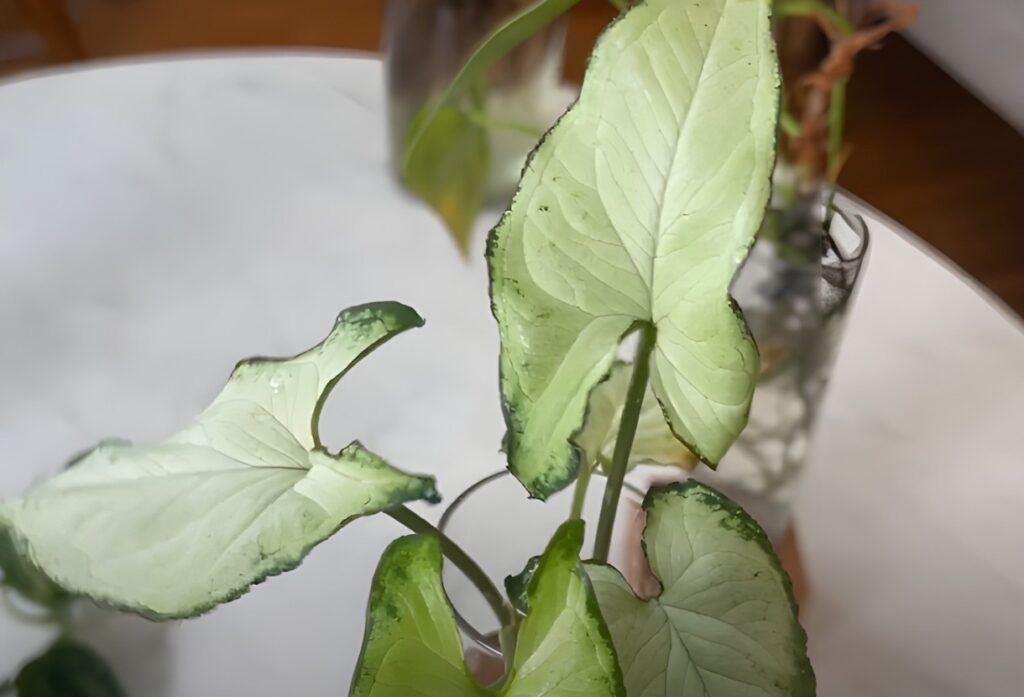
Botrytis Blight
Do your Caladium leaves with vibrant colors start to fade? It could be Botrytis Blight that is responsible for this. While this fungal disease likes the dampness, it attacks your plant’s foliage and leaves them with yellowing of the same.
In such a case, humidity levels are high and airflow is poor, your Caladium becomes vulnerable to the charms of Botrytis Blight.
How to Fix It
The rejuvenation of your Caladium’s full glory is a two-pronged approach. First, cut off infected leaves so as to contain the blight.
Second, enhance ventilation and minimize the humidity around the plant by a proper spacing of them and preventing overwatering. You may want to use a botrytis fungicide.
Root Rot
Your bright caladium leaves could turn yellow because of a cunning enemy, which is root rot. This fungus proliferates well in wet soils, invading the roots of the plant and disrupting nutrient uptake.
However, root rot is caused by lack of drainage in the soil or overwatering that allows this blight to thrive.
How to Fix It
So that to save your caladiums from the shackles of root rot, begin by changing your watering schedule. Let the soil dry out between watering, and allow for good drainage.
Cut back affected roots and replant your caladiums into new, well-drained soil. Throw in a fungicide to battle the remaining fungal presence, and think about giving your plants new housing where they might have better access to indirect sunlight.
Pest Infestation
Caladiums’ captivating allure can be dulled by the yellowing of their leaves, which is often an indication of a pest infection. Present are aphids, spider mites and nematodes who feed on the vitality of plants.
Tiny aphids feed on sap and leave yellow trails behind them. Spider mites spin the fine webs and make leaves become pale in their viability.
Nematodes although invisible, feed on roots interfering with nutrient absorption. The identification of these symptoms is critical in early intervention.
How to Fix It
There are many facets of fighting pests. Start by quarantining plants with the disease to avoid transmission. Use beneficial insects such as ladybugs that eat aphids.
Spraying off the foliage with water on a regular basis will help dislodge spider mites. The use of neem oil or insecticidal soap for treatment enables pest control while reducing damage to the plant.
Nutrient Deficiency
So we told you that Low value nutrient is the main cause of caladium leaves turning yellow.
Such tropical beauties prefer nutritional balance, and lack of nitrogen, iron, or potassium will result in yellowing. Nitrogen lack usually leads to the yellowing leaves, while iron and potassium shortage cause edge-yellowed leaves.
How to Fix It
To restore the color on your Caladium you need a swift nutrient injection. Start with a balanced fertilizer that contains nitrogen, iron, and potassium.
Go for a formula that releases the nutrients slowly over time. Watering correctly because absorption of the nutrient is closely related to water content.
Fertilizer Burn
In case your brightly colored caladium leaves turning yellow all of a sudden, fertilizer burn is the most likely suspect.
Although the goal is to fortify, too many fertilizers can burn through the roots which in turn prevents nutrient absorption and results to yellowed leaves.
How to Fix It
Do not be afraid, for regaining the splendor of your caladium is achievable. Start by leaching the soil using water to eliminate excess salts.
Reduce yellow leaf growth by trimming. Balance your fertilizing routine, settling for a diluted mixture.
Low Humidity
Low humidity seems to be responsible for the caladium leaves turning yellow. Caladiums are ideal plants in high-humidity environments and when levels fall below certain limits these tropical beauties may suffer.
Lack of moisture in the atmosphere may inhibit their capacity to take up water through their leaves, resulting to yellowing.
How to Fix It
Do not be afraid, because there are real ways to help fight low humidity and restore life to your caladiums. First, you may want to move your plants to a warmer and more humid location, or use a humidifier nearby.
Misting on a regular basis can also work miracles, as it brings moisture if in short supply. Combining plants together allows the formation of microclimate with more humidity.
How to Prevent Caladium Leaves turning yellow
As fantastic as they are, caladiums can sometimes cause yellow leaves to appear in one’s garden. Here’s a friendly guide to help you maintain those vibrant hues:
- Sunlight Balance: Caladiums prefer shade, so give them partial sunshine to avoid turning yellow. It is best to have a dappled shade or light from morning sun.
- Well-Drained Soil: These gems grow in well-drained soil. Choose a moisturizing mix that does not become saturated.
- Regular Watering: Make sure that the soil is always moist, but do not overwater. Therefore, a balanced watering routine is vital to avoid yellow leaves.
- Feeding Schedule: During the growing season, caladiums need a regular feeding routine. Use a well-balanced fertilizer to supply without causing overload.
- Temperature Consideration: Keep the temperature warm because caladiums grow best in temperatures above 70°F (21°C). Keep them away from cold drafts.
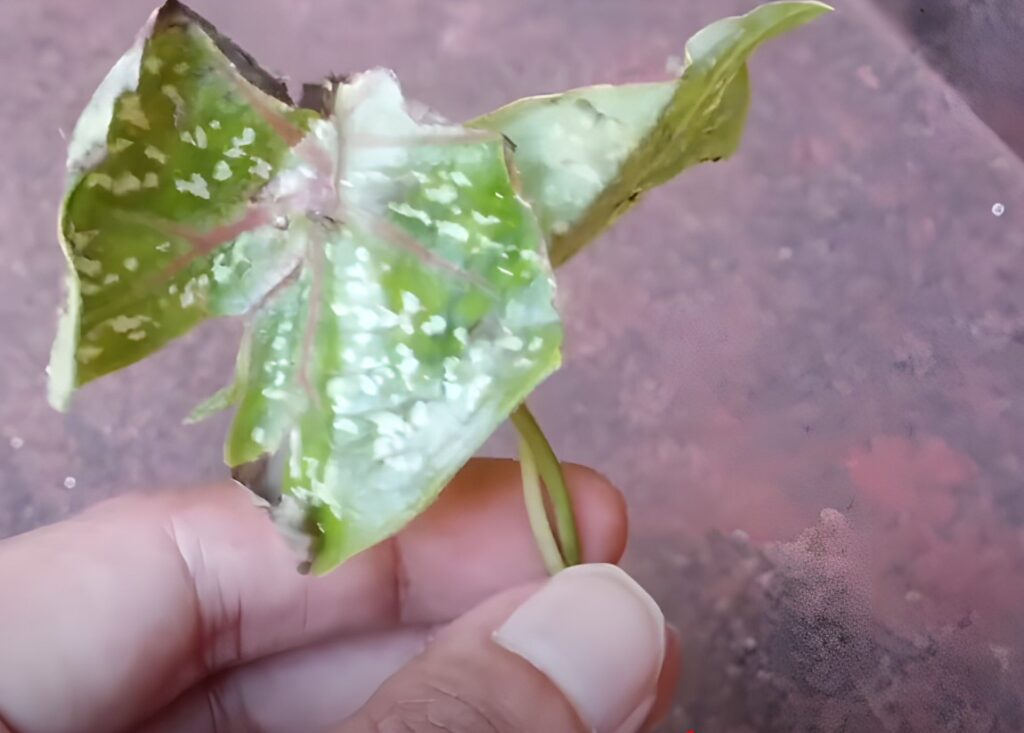
How do you take care of yellow Caladium leaves?
- Assess Light Conditions: Make sure your Caladium has an appropriate amount of light. These colorful plants thrive in partial shade. Place them in a shaded area.
- Watering Routine: Caladiums prefer moist soils that are neither overly wet nor drying. Change the watering routine to avoid bogged roots and make sure that water drains well.
- Humidity Matters: These beautiful tropes thrive in high humidity. Regular misting of the leaves or placing a tray with water nearby will make sure that there is sufficient moisture content in the environment to form a humid microclimate.
- Fertilize Wisely: During the growing season, apply a well-balanced water-soluble fertilizer every 4 to 6 weeks to your Caladiums. Don’t fertilize too much because it causes leaf burn.
- Inspect for Pests: Yellowing leaves may indicate pest infestations. If spider mites or aphids appear, treat accordingly.
Comprehensive guide to Effective Caladium Plant Care and Troubleshooting Yellowing Issues
Effective caladium plant care is crucial for maintaining vibrant foliage. If you notice caladium leaves drooping and turning yellow, it might indicate issues such as overwatering or inadequate drainage. Similarly, caladium leaves turning yellow and brown may signal both overwatering and insufficient sunlight.
Understanding why your caladium leaves are turning yellow involves considering factors like watering frequency and light exposure. Curling and turning yellow leaves may suggest dehydration or pest infestation. In Canada, where the climate varies, adjusting care to the specific region is vital.
To prevent leaves from turning yellow, especially in the growing phase, ensure well-draining soil and proper watering. If leaves turn green and yellow or hard yellow, the plant may need more sunlight. Java, known for its lush landscapes, might pose unique challenges, so closely monitor caladium leaves turning yellow on top or pale yellow.
Pruning can be a solution to rejuvenate yellowing foliage. Quick yellowing may demand immediate attention, and a comprehensive treatment plan, considering factors like soil health and pests, can address the issue. Whether in the UK or zones with distinct climates, understanding your caladium’s needs, and promptly addressing yellowing, is key to a thriving plant.
Additionally, exploring various caladium varieties, such as lemon blush, white lightning, red flash, or tricolor, adds a delightful touch to your garden. Keep an eye on caladiums like the green treasure and yellow variety, adjusting care accordingly.
In general plant care, addressing yellow leaves on plants requires identifying the root cause, be it nutritional deficiencies or environmental stress. Whether it’s a ZZ plant with yellow leaves or other houseplants, a prompt response and corrective measures can often save the plant.
Understanding the significance of yellow leaves and implementing appropriate care can contribute to the overall health of your plants. Lastly, miscellaneous aspects like caladium gelbe blätter, caladium geht ein, caladium hängt, caladium umtopfen, caladium verliert blätter, caladium welke blätter, and caladium zwiebel introduce additional considerations for specific issues, offering a holistic approach to successful caladium plant care.
FAQs
Why are my caladiums turning yellow?
Caladiums can turn yellow from overwatering, too little light or poor drainage. Modify watering, filter light, and allow for adequate drainage.
How do you keep caladiums happy?
Ensure successful growing of caladiums by keeping them in filtered sunlight and providing consistent moisture in the soil, adequate humidity levels, as well as feeding with a balanced water-soluble fertilizer.
How do you make caladiums fuller?
In order to produce fuller caladiums, support the plant’s healthy growth by fertilizing, proper watering, and allowing appropriate light exposure. Trim selectively to encourage shaping and fullness.
Why is my caladium losing color?
Caladiums can turn color from the lack of light, pests, or old leaves. Handle lighting issues, look for pests, and prune yellow or faded leaves to create a lush display.
Can Removing Yellow Leaves Help?
Yes, getting rid of yellow leaves can help the plant concentrate on healthy ones which helps in improving the health of a caladium and keeping its colorful appearance.
Can Yellow Leaves Turn Green Again?
No, once caladium leaves turn yellow they will not be green again. Pay attention to the prevention of further yellowing by targeting issues related to light, water, and nutrient balance.
Is it necessary to cut off yellow leaves from a caladium plant?
Yes, one should trim the yellow leaves of a caladium plant using clean scissors. This in turn enhances the appearance of the plant and redirects energy to better parts.
Does a lack of nitrogen cause yellow caladium leaves?
A lack of nitrogen can indeed lead to yellow caladium leaves. Approach a balanced fertilizer that is rich enough in nitrogen to boost healthy foliage production.
Will too much water cause my caladium leaves to turn yellow?
Yes, too much water causes yellow caladium leaves as a result of root rot. Keep the soil well drained and water consistently to avoid wet conditions.


